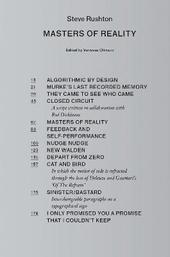
|
Masters of Reality
Hardback
Main Details
| Title |
Masters of Reality
|
| Authors and Contributors |
By (author) Steve Rushton
|
|
Edited by Vanessa Ohlraun
|
| Physical Properties |
| Format:Hardback | | Pages:192 | | Dimensions(mm): Height 187,Width 129 |
|
| Category/Genre | Theory of art |
|---|
| ISBN/Barcode |
9783943365221
|
| Audience | |
|---|
| Illustrations |
20 B&W ILLUS.
|
|
Publishing Details |
| Publisher |
Sternberg Press
|
| Imprint |
Sternberg Press
|
| Publication Date |
6 April 2012 |
| Publication Country |
United States
|
Description
Masters of Reality brings together the first collection of texts by Steve Rushton. Second in a series of publications on contemporary art inaugurated by the Piet Zwart Institute, the book explores the interrelations between art, anthropology, social sciences, psychology, media, politics, and economy. Central to Rushton's research is an investigation into the conception of feedback, social control, and the culture of "self-performance." Through his writings and collaborative work with artists, he has developed and articulated a thorough analysis of the techniques and processes of information management and subjectivization in Western society since the second half of the twentieth century.The structure of this book articulates a clear relationship between diverse subjects and sources, drawing from archival materials produced within a broad range of discursive fields and practices- military experiments in social psychology, press statements by various politicians and governments, anthropological research data, theories of cybernetics, writings by thinkers such as Henri Bergson and Gregory Bateson, television culture, and work by artists and writers such as Ant Farm and Don DeLillo. These investigations take structural form through three strands- the first comprises texts on art and media linked to theories of cybernetics, the second thread shows texts that emerge from Rushton's collaborative projects with Rod Dickinson and Thomson & Craighead, and the third is a collection of fictional and allegorical texts, giving narrative form to the thinking, observations, and analysis found throughout the book. Co-published with Piet Zwart Institute, Willem de Kooning Academy
|